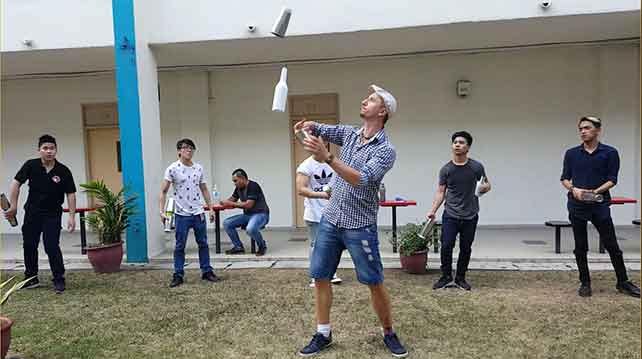Here is a common scenario: A guest orders a drink at the bar. After a few minutes, he decides to start a conversation with the bartender about his profession and what it’s like working behind the bar. Somehow, the conversation always leads to the question of “So, do you know how to juggle?”
Wait a minute now, are we in a bar or a circus?
What the guest is actually trying to refer to is what the industry knows as ‘flair bartending’, ‘flairing’ or simply, ‘flair’. According to the Flair Bartenders’ Association (FBA) in America, flair bartending is technically the act of flipping, spinning, throwing, balancing and catching bottles, drinks and other bar tools while in the process of making a cocktail.
It has actually been around for a long time, at least 150 years in fact. In the 1800s, the fabled bar legend Professor Jerry Thomas was deemed the first to introduce fancy showman ways into his mixing of drinks. The most prominent was the Blue Blazer cocktail, which requires a flamed whisky mixture to be passed between two metal vessels, creating an arc of fire, before serving. But it wasn’t until about the 1980s that flair really began to gain recognition. In 1986, TGI Friday’s in the USA was the first F&B establishment to fully introduce and promote such showmanship as defined by the FBA while making their drinks.
But possibly the biggest reason that the whole world seems to be more aware of flairing than the actual art of mixing drinks would be due to the making of the movie Cocktail in 1988. Thanks to the popularity of this movie headlined by Tom Cruise, bars around the world started trying to cash in on this flashier style of pouring drinks, encouraging most of their bartenders to learn to flair because of its entertainment value – which could relate to better sales and tips.
Unfortunately, this planted a firm perception on the part of customers that all bartenders can flair, but this is no longer the case. However, this trend is slowly starting to change as bartenders and the public alike are starting to appreciate the actual art and science that goes into making a cocktail.
Flair bartending can be broken down to two main styles – exhibition flair and working flair. Exhibition flair is performed for entertainment and competition purposes and involves choreographed moves with 2, 3, 4 or 5 bottles and/or tins. This type of flair is not encouraged in the actual bar setting as there is too much risk involved although lots of bars, especially in Las Vegas, still do it as part of the entertainment. Working flair on the other hand comprises quick, light moves that can realistically be performed without really jeopardising the preparation time of a drink. Simple moves like a flip of a glass or tossing the garnish into the air and catching it in the drink or a bottle catch behind the back are examples of working flair.
So which style of flair is the best? Neither. Both styles have their place and purpose. But the question is, with all the theatrics and visual experience, does it translate into a good cocktail at the end of the day? In future, we will explore further more versions and definitions of flair from other parts of the world. Till then, happy flairing!
(By the way, almost all bartenders get annoyed by the ignorant use of the term ‘juggle’ instead of ‘flair’. It’s a bartenders’ thing, whether we do flair or not!)

Subscribe To The Newsletter